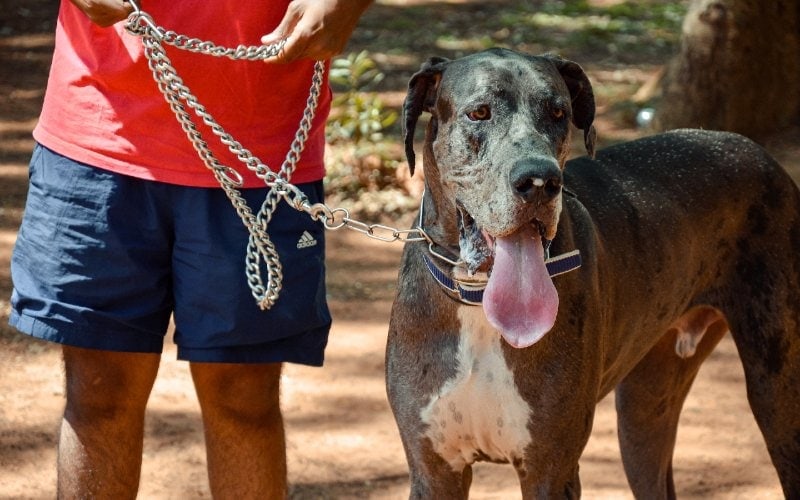As a vet, am I going to say a little sun is bad for your dog? No, of course not. But is too much sun bad for your dog? Yes, I am.
But what is a little bit of sun? What is too much sun? Good question. Even the literature is vague on the ‘correct’ amount of sunlight because dogs live everywhere on earth, with all sorts of levels of sun intensity. Plus, there are so many different types of dogs that their individual needs will be different. A white, thin-skinned greyhound will have a very different relationship to sunlight than a husky.
If you are curious to learn more about whether dogs need sunlight to be healthy, this article will be useful.
Do Dogs Benefit From Sunlight?
Lately, human medicine has been particularly interested in the benefits of sunlight, especially in terms of vitamin D and seasonal affective disorder. And along with this interest in humans, the interest in the effects of these conditions has increased in dogs, but the research is still very limited. But, in general, it suggests that dogs do not benefit from sunlight in the same way as humans.

What About Vitamin D?
Published scientific literature demonstrates that dogs do not need sunlight to generate and metabolize vitamin D in the same way as humans.
Some species have evolved to absorb vitamin D through a complex pathway that requires sunlight and skin, but other species have evolved to get it through their diet alone.
Birds, cows, sheep, pigs, and humans need to get vitamin D using sunlight and their skin. But dogs and cats do not; they get all their vitamin D from their diet. In fact, they can’t process vitamin D on their skin at all. So, there is no real need to worry about your dog not getting enough vitamin D in the winter as long as they are on a healthy diet.

Seasonal Affective Disorder: Does Sunlight Make Dogs Happy?
Mental health disorders are very difficult to document and study even in humans. In dogs, there is very little research specifically on this disorder. However, some evidence suggests sunlight is not as important as exercise. Even in humans exercise is a well-known therapy for this disorder, and it is likely that in dogs, exercise is more important than light—and it’s more controllable!
For example, a study that measured melatonin in dogs found that “the factor showing the most pronounced reductions in plasma melatonin levels…was exercise”. Now melatonin is not depression. But this study suggests that while sunlight can affect hormones in the brain, exercise is just—if not more—powerful at improving moods in dogs.
Health Problems From Sunlight
The problems from prolonged sun exposure are also more researched and popular in humans and dogs these days. It is lucky that dogs only get cuter as they get older.
1. Skin Cancer
Just like in humans, too much direct sunlight can cause skin cancer. In fact, the most common type of malignant—dangerous—skin cancer in dogs is squamous cell carcinoma, which is highly associated with sun ultraviolet light.
It is usually found on body parts with less hair or fur, such as under the belly or on the legs.
These cancerous lumps can look very different but are often raised on the skin’s surface and are red and raw. They can have discharge or crusts, and sometimes they look like warts. If you find a new and strange lump on your dog, have your vet examine it and take a sample for testing.
2. Solar Keratosis
After direct exposure to the sun, over long periods, a dog’s skin can thicken and darken in spots called solar keratosis. If your dog has these skin changes, they are more likely to develop skin cancer.
3. Sunburn
Sunburn in dogs also occurs on spots where there is less fur. Just like humans, it can become very red and sore and cause permanent damage and scarring to the skin, such as solar keratosis. It also predisposes dogs to skin cancer.
4. Overheating
Dogs can very quickly overheat in the sun. Even on a cool day, with direct sunlight, some dogs will still get hot quickly. Be aware of keeping dogs in the sun and always make sure they have a place to escape its direct rays. Always make sure they can get out of the sun and into the shade.

Frequently Asked Questions (FAQs)
Should I get a sunlamp for my dog?
I think the general veterinary consensus concerning sunlamps and heat lamps is that they are almost always too devastatingly dangerous to outweigh their—negligible—benefits.
Animals do not understand how dangerous sun and heat lamps are, and they do unsafe things like lay right on top of them until they burn themselves, or they toss a blanket over them and cause a fire. There are thousands of stories of animals getting hurt from heat and sun lamps, even in controlled and monitored settings. Burning your house down is not worth the minimal benefits your dog will not get from a sunlamp.
Yes, there are lights that provide UV light for reptiles and amphibians safely at home, but these are used in a pretty controlled environment. And the benefits to these species are very real, whereas the benefits to dogs are non-existent in comparison.
Are dogs affected by a lack of sunlight?
There is little evidence suggesting that dogs are affected by a lack of sunlight. Most likely, if your dog acts healthier or happier after sun exposure, it has to do with the extra exercise and mental stimulation of being outside. Or a dog may enjoy the warmth from laying in the sun and act happier, but the physiological benefits are unknown, if not negligible.

How long should I let my dog lay in the sun?
This depends on how intense the sunlight is and the type of dog you have. The sun in the winter is not as intense as the summertime sunlight. And the sun in Sydney is not the same type of intensity as the sunlight in Vancouver. If you live in an area with intense sunlight, and it’s the right time of year, be more careful.
If your dog has a big hairy coat, it is more likely to overheat and less likely to get skin cancer because the sun will heat its coat quicker but it will not penetrate its skin fast enough. However, if you have a dog with a thin coat, the sun will penetrate its skin faster, but it will not get hot as quickly, so it will stay in the sun longer.
How can I protect my dog from too much sun?
- Light tee-shirts
- Dog-safe sunscreen
- Provide shade
- Move them out of the sun
Conclusion
While the sun has some demonstrable benefits to human health, there is no evidence that dogs receive the same benefits. In fact, in a veterinary clinic, the negative effects of the sun (such as skin cancer and overheating) are so much more common and devastating that any real or imagined benefits are completely negated.
Featured Image Credit: Jumpstory
Contents
- Do Dogs Benefit From Sunlight?
- What About Vitamin D?
- Seasonal Affective Disorder: Does Sunlight Make Dogs Happy?
- Health Problems From Sunlight
- Frequently Asked Questions (FAQs)
- Should I get a sunlamp for my dog?
- Are dogs affected by a lack of sunlight?
- How long should I let my dog lay in the sun?
- How can I protect my dog from too much sun?
- Conclusion











